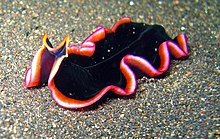
Any worm that lives in a marine environment is considered a water worm. Marine worms are found in several different phyla, including the Platyhelminthes, Nematoda, Annelida, Chaetognatha, Hemichordata, and Phoronida. For a list of marine animals that have been called "sea worms", see sea worm.

Animal sexual behaviour takes many different forms, including within the same species. Common mating or reproductively motivated systems include monogamy, polygyny, polyandry, polygamy and promiscuity. Other sexual behaviour may be reproductively motivated or non-reproductively motivated.

The Polycladida represents a highly diverse clade of free-living marine flatworms. They are known from the littoral to the sublittoral zone, and many species are common from coral reefs. Only a few species are found in freshwater habitats.

Penis fencing is a mating behavior engaged in by many species of flatworm, such as Pseudobiceros hancockanus. Species which engage in the practice are hermaphroditic; each individual has both egg-producing ovaries and sperm-producing testes.

Pseudocerotidae is a family of flatworms which includes the Bedford's flatworm. Pseudocerotidae are simple organisms categorized by their oval bodies and tentacles and bright colors. They use the cilia to glide along surfaces. Most commonly referred to as marine flatworms, closely related to the orders Macrostomorpha and Lecithoepitheliata. These organisms have very complex reproductive systems, no blood systems or organs for gas exchange, a simple brain and are hermaphroditic.

Traumatic insemination, also known as hypodermic insemination, is the mating practice in some species of invertebrates in which the male pierces the female's abdomen with his aedeagus and injects his sperm through the wound into her abdominal cavity (hemocoel). The sperm diffuses through the female's hemolymph, reaching the ovaries and resulting in fertilization.

Bispira brunnea, the social feather duster or cluster duster, is a species of marine bristleworm. They tend to live in groups of individuals, and are common off the Caribbean islands in southeast North America. The feather duster has one crown of various colors, however, the color of the crown seems to be consistent within individual colonies.
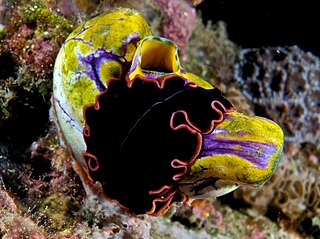
Pseudobiceros is a genus of flatworms. Like all flatworms, Pseudobiceros are hermaphrodites. This particular genus engages in penis fencing. When the "winner" touches its penis to the "skin" of the other, insemination occurs, and the "loser" has to bear the burden of motherhood.
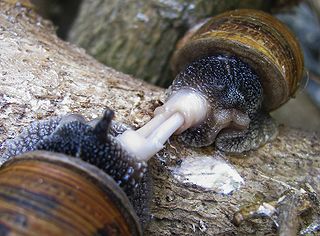
A hermaphrodite is a sexually reproducing organism that produces both male and female gametes. Animal species in which individuals are of different sexes, either male or female but not both, are gonochoric, which is the opposite of hermaphroditic.
The purple-lined wrasse, also known as the lavender wrasse, is a species of wrasse native to coral reefs of New Caledonia and Australia, where it can be found at depths from 20 to 55 m. This species can reach a total length of 12 cm (4.7 in). It can be found in the aquarium trade. As a member of the family Labridae, Cirrhilabrus lineatus displays hermaphroditic behavior where a female may become a male when it is biologically favorable to do so. Generally, this occurs when competition from larger males disappears.

Pseudoceros dimidiatus, the divided flatworm or tiger flatworm, is a species of flatworm in the genus Pseudoceros, belonging to the family Pseudocerotidae.

Pseudobiceros bedfordi is a species of flatworm in the family Pseudocerotidae.

Callyspongia (Cladochalina) aculeata, commonly known as the branching vase sponge is a species of sea sponge in the family Callyspongiidae. Poriferans are typically characterized by ostia, pores that filter out plankton, with an osculum as the opening which water leaves through, and choanocytes trap food particles.

The yellowhead wrasse is a fish species belonging to wrasse family native to shallow tropical waters in the Caribbean Sea and western Atlantic Ocean.
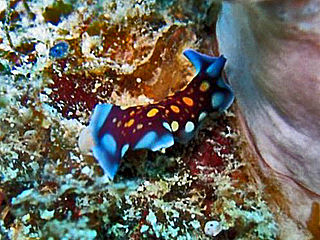
Pseudoceros lindae, common name Linda's flatworm, is a marine Flatworm species that belongs to the Pseudocerotidae family.

Thysanozoon nigropapillosum is a species of polyclad flatworms belonging to the family Pseudocerotidae. Some common names include Gold-speckled flatworm, Marine flatworm, Yellow papillae flatworm, Yellow-spotted flatworm, and Yellow-spotted polyclad flatworm.

Halichoeres leucoxanthus, commonly called the canarytop wrasse, whitebelly wrasse, or lemon meringue wrasse, is a fish species in the wrasse family endemic to the Indian Ocean.
Macrostomum rostratum is a free-living, hermaphroditic flatworm in the family Macrostomidae, found in freshwater and brackish environments.
Waminoa brickneri is a newly discovered acoel species from the coral reefs near Eilat and the second described species in the genus.
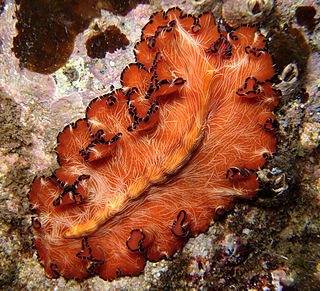
Pseudobiceros fulgor, also known the lightning worm, is a species of marine flatworm from the family Pseudocerotidae and belongs to the class Turbellaria. These flatworms are commonly found in the tropics of the Indo-Pacific region. They can be found in shallow coral reef environments.
